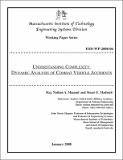| dc.contributor.author | Minami, Nathan A. | |
| dc.contributor.author | Madnick, Stuart E. | |
| dc.date.accessioned | 2016-06-02T19:50:40Z | |
| dc.date.available | 2016-06-02T19:50:40Z | |
| dc.date.issued | 2008-01 | |
| dc.identifier.uri | http://hdl.handle.net/1721.1/102860 | |
| dc.description.abstract | Dozens of U.S. soldiers are killed each year as a result of both combat and motor vehicle accidents. The objective of this study is to look beyond the events and symptoms of accidents which normally indicate human error, and instead study the complex and poorly understood upper-level organizational processes and problems that may constitute the actual root causes of accidents – this is particularly challenging because the causes often involve nonlinear dynamic phenomena and have behaviors that are counter-intuitive to normal human thinking, these are often called “wicked” problems. After reviewing the available literature, a System Dynamics model was created to provide an analytical model of this multifaceted system that allows for extensive simulation. The results of these simulations suggest that high-level decisions that balance mission rate and operations tempo with troop availability, careful management of the work-rest cycle for deployed troops, and improvement of the processes for evaluating the lessons learned from accidents, will lead to a reduction in Army combat and motor vehicle accidents. | en_US |
| dc.language.iso | en_US | en_US |
| dc.publisher | Massachusetts Institute of Technology. Engineering Systems Division | en_US |
| dc.relation.ispartofseries | ESD Working Papers;ESD-WP-2008-06 | |
| dc.title | Understanding Complexity: Dynamic Analysis of Combat Vehicle Accidents | en_US |
| dc.type | Working Paper | en_US |
